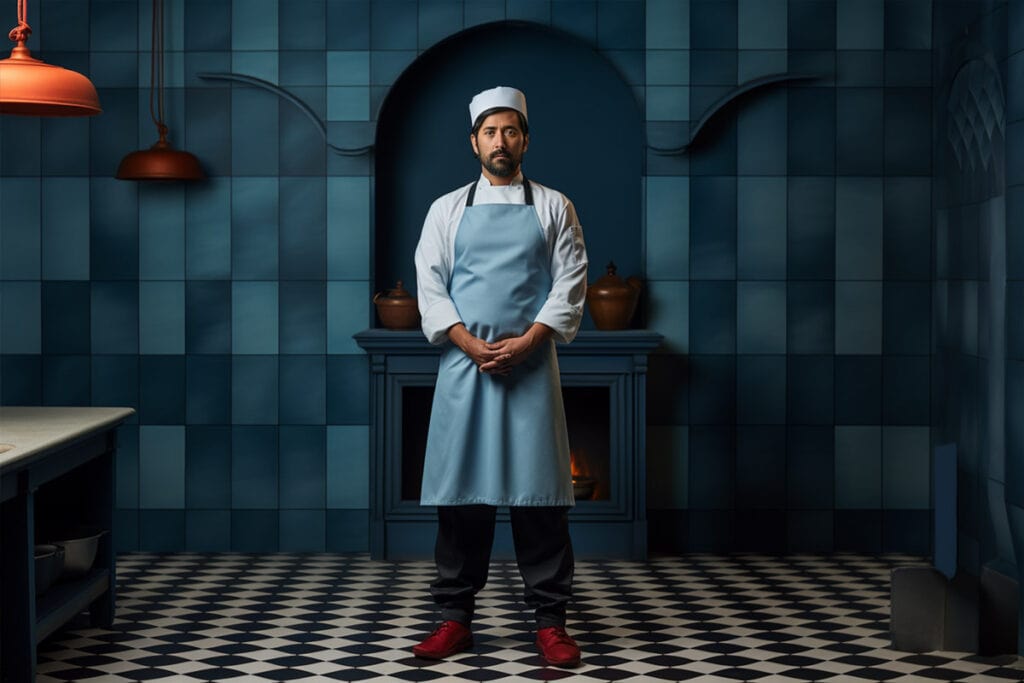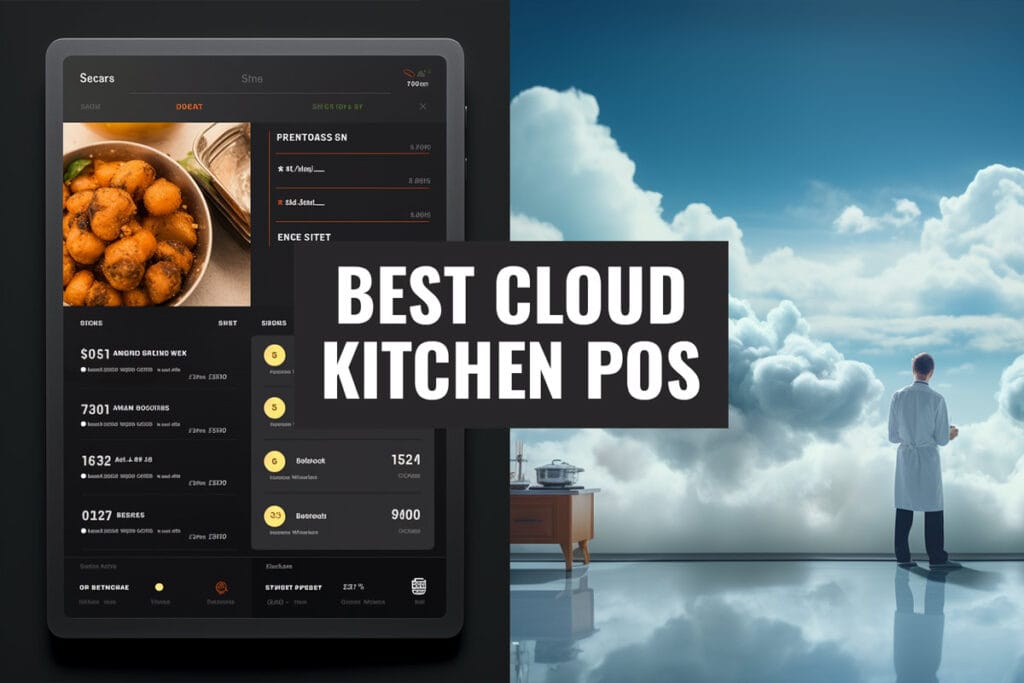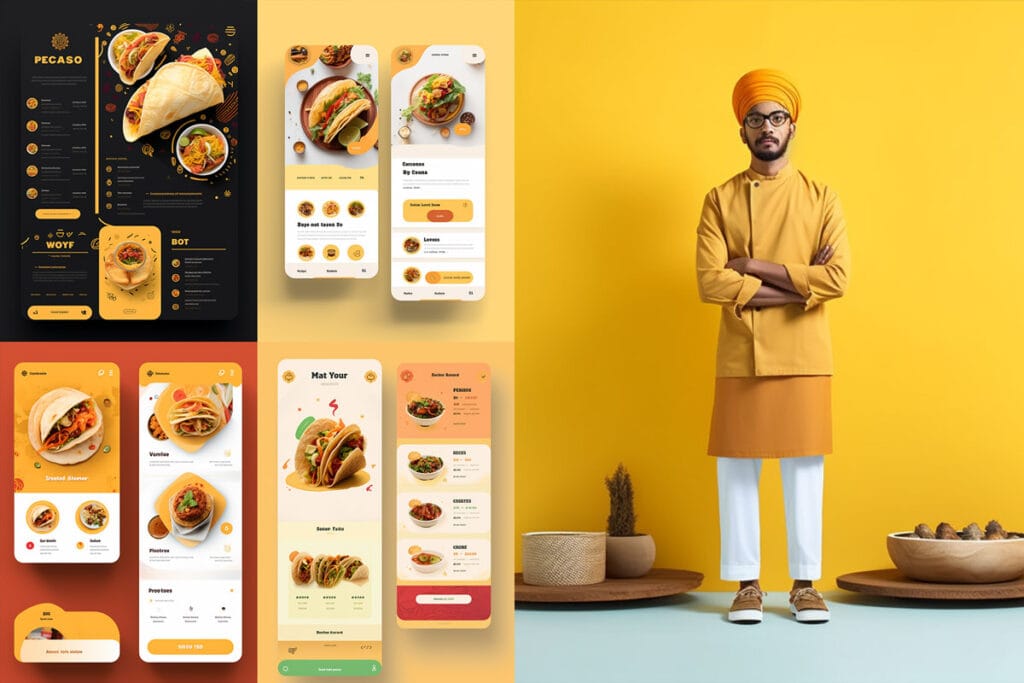Ghost kitchen, dark kitchen, virtual kitchen, cloud kitchen – whatever you want to call it, this innovative restaurant concept is disrupting the food industry.
If you’re looking to start a ghost kitchen and get into the restaurant business with lower overhead, this step-by-step guide will walk you through everything you need to launch your own successful ghost kitchen.

What Is a Ghost Kitchen and How Does It Work?
A ghost kitchen is a professional food preparation business that cooks meals exclusively for delivery.
Ghost kitchens allow restaurants to prepare food without having a physical dining room or storefront. They operate out of low-cost commercial kitchen spaces optimized for food preparation and delivery logistics.
The concept first emerged in the early 2010s as food delivery services like Grubhub and DoorDash gained popularity. Large chains and startup brands alike saw the opportunity to open delivery-only locations to reach more customers without high real estate costs.
The global market size of ghost kitchens was valued at over $56 billion in 2021 and is expected to continue growing rapidly, with over 100,000 ghost kitchens now operating worldwide [Source].
The rapid growth demonstrates the massive potential ghost kitchens have to disrupt the restaurant industry. As customer adoption continues rising, ghost kitchens will unlock lucrative opportunities for digital-first food brands.
The Main Ghost Kitchen Models:
- Standalone virtual restaurant with own brand and menu
- Shared kitchen hub preparing food for multiple brands
- Existing restaurant uses kitchen for virtual concepts during off-peak hours
- Rent a modular “kitchen pod” from providers like CloudKitchens

Step 1: Create a Ghost Kitchen Business Plan
To start a successful ghost kitchen, you need to build out a thorough business plan first. Here are some tips on creating a strategic ghost kitchen business plan:
- Research the ghost kitchen landscape – Study competitors, trends, and operations models to make informed decisions. Know your local delivery app landscape.
- Determine your business model – Will you operate as a single delivery-only brand or use a shared kitchen to prepare food for multiple virtual restaurants?
- Create a concept and menu – Develop a compelling brand identity and optimized menu to differentiate yourself. Focus on food that travels well.
- Find a commercial kitchen – Determine if leasing an existing space or building out your own is better based on budget and location.
- Evaluate technology needs – Choose tools for online ordering, POS, inventory, kitchen displays, and delivery logistics.
- Build a staffing plan – Create a lean team focused on kitchen operations rather than servers. Hire delivery drivers if needed.
- Project costs and financing – Calculate startup costs and project revenue and expenses. Determine how much funding you’ll need.
- Make a marketing plan – Figure out how you’ll promote your ghost kitchen to drive awareness and trial. Leverage delivery app features too.
Having a strategic business plan is key for opening and running a successful ghost kitchen. It keeps you focused and helps secure funding.
Read more: How to Write a Ghost Kitchen Business Plan (With Examples)

Step 2: Create Your Ghost Kitchen Concept and Menu
Your virtual restaurant needs a strong concept and tailored menu to thrive. Here are some tips:
- Define your brand identity – Create a memorable name, logo, and visual branding that communicates your concept. This will be your main marketing tool since you don’t have a storefront.
- Determine your cuisine – Research successful virtual restaurants and food trends, but also look for gaps you can uniquely fill. Popular options are pizza, burgers, wings, tacos.
- Craft your core menu – Design a focused menu of 5-10 signature dishes you’ll come to be known for. Simple, consistent recipes are best.
- Add versatility – Offer different prices, formats, and options for customization. Include vegetarian, vegan, and gluten-free items to broaden appeal.
- Focus on bestsellers – Analyze competitors’ top sellers and consider featuring those proven popular menu items.
- Make dishes delivery-friendly – Avoid messy or fragile components. Lean towards food that holds up during transit.
- Price competitively – Research other delivery options in your area and price your menu accordingly. Delivering value will help drive trial.
- Refine logistics – Test your menu end-to-end – from order to production to packaging to delivery. Tweak recipes and processes to maximize quality and efficiency.
- Plan limited-time offers – Prepare holiday, seasonal, or collaboration menus to generate buzz. Bring back popular LTOs.
Starting with a core focus and tailoring your operation specifically for off-premises dining is key. Constantly refine the concept and menu based on customer data.

Step 3: Find a Commercial Kitchen Space
One of the biggest decisions you’ll make when starting a ghost kitchen is finding the right commercial kitchen to operate out of. Here are a few ghost kitchen location options to consider:
- Lease an existing restaurant space – This allows you to customize but requires a long-term lease. Best for dedicated ghost kitchens.
- Shared commercial kitchen – Rent by the hour in a commissary kitchen used by multiple businesses. Very flexible but with less control.
- Kitchen hub – Lease space in a multi-restaurant ghost kitchen facility. Turnkey setup but less customization.
- Convert existing space – Take over an empty restaurant space, or food truck kitchen, or repurpose a warehouse. More work but potentially cheaper.
- Build out a new space – Construct a custom delivery-only kitchen if you have the budget. Ideal but very expensive.
Make sure to evaluate infrastructure like ventilation, fire suppression, permits, parking, and accessibility based on your equipment needs. Being close to your target customers and delivery hubs is ideal as well.
Many ghost kitchen operators opt to lease space in an existing commercial kitchen or hub to keep costs low at the outset. This also allows more flexibility to relocate as you grow.
Step 4: Setting Up Your Ghost Kitchen
Once you’ve secured your commercial kitchen, it’s time to fit it out with all the equipment you’ll need to start cooking.
An efficient ghost kitchen setup includes:
- Commercial cooking equipment like ranges, ovens, broilers, and grills
- Stainless steel worktables and sinks
- Commercial refrigerator and freezer
- Storage shelves for dry goods
- Fire suppression system
- Ventilation hoods
- Hand washing station
- Food prep tools and small wares
- Digital menu boards or kitchen display system
You’ll also need:
- Ghost kitchen POS system tailored for online ordering
- Tablets and printers for delivery ticket management
- Packaging supplies like to-go containers and bags
Don’t overlook small details like lighting, flooring, cleaning tools, and first aid kits. Having an optimized workflow is also key to maximizing output.
Many ghost kitchens operate with around 1,200 – 1,500 square feet but you can start smaller and expand as needed. Used equipment can help reduce initial costs too.

Step 5: Choose a Ghost Kitchen POS System
A purpose-built POS system is an essential technology for running a streamlined ghost kitchen operation. Here’s why:
- Automatically receives and organizes orders from your website, apps, and phone into one place to prevent duplication.
- Optimized order management sends orders to the kitchen and tracks status through prep and delivery.
- Provides data and reporting on sales, menu items, order times, costs, and other metrics to refine operations.
- Allows easy menu, pricing, and order option updates across all online order channels.
- Integrates with delivery dispatch to optimize routing and provide digital delivery proofs.
- Manages customer data and order histories for CRM and personalized marketing.
- Offers add-ons like loyalty programs, inventory, accounting, and warehouse integrations.
A ghost kitchen POS removes huge headaches by coordinating the fragmented processes and platforms of a ghost kitchen for maximum efficiency. The costs are well worth it for long-term optimization and growth.
You may also like our review of the 6 Best Cloud & Ghost Kitchen POS Systems

Step 6: Launching and Marketing Your Ghost Kitchen
Once your virtual restaurant is ready to open, you need to focus on getting the word out and driving customers. Here are some ghost kitchen marketing strategies to implement:
- Build a website – This is the hub for all information about your concept, menu options, ordering, delivery radius, etc. Make it easy for customers to order directly from you.
- Leverage delivery apps – List your ghost kitchen on every popular platform available in your area like DoorDash, UberEats, Grubhub, etc.
- Run promotions with delivery partners – Take advantage of promotional features like free delivery, boosted placements, and sponsored listings.
- Create social media accounts – Build an audience on Facebook and Instagram through content, offers, and advertising.
- Focus on SEO – Optimize online listings and content with relevant keywords so customers can easily find you.
- Distribute menus – Print menus and flyers to reach customers in your delivery zone who may not be on delivery apps yet.
- Partner with neighboring businesses – Offer discounts or promotions at nearby offices, schools, etc. in exchange for marketing access.
- Collect customer feedback – Ask for reviews on delivery apps and social. Use feedback to improve operational issues and promote favorites.
- Analyze performance data – Track key metrics like sales by dish, delivery times, costs per order, etc. to refine operations.
Consistently marketing your ghost kitchen is vital since you don’t have the visibility of a storefront location. Take advantage of every digital platform and local partnership possible to build awareness.
Step 7: Managing Operations and Delivery as a Ghost Kitchen
Running efficient kitchen operations and delivery logistics is how ghost kitchens thrive. Here are some tips:
- Optimize your kitchen workflow – Design an efficient layout and processes to meet delivery timelines. Use tools like kitchen display systems to coordinate orders.
- Hire specialized staff – Your team only needs kitchen talent focused on food prep and delivery, not servers.
- Implement inventory controls– Closely track raw ingredients and prepared item quantities using digital tools. Keep limited redundancies on hand.
- Refine food prep recipes – Analyze dish prep times and tweak recipes to increase output potential.
- Focus on packaging – Invest in packaging that keeps food looking great during delivery and minimizes spills.
- Choose the right delivery radius – Balance proximity with demand based on your kitchen capacity when setting delivery zones.
- Monitor delivery times – Track when orders are placed versus when they arrive. Adjust processes and radii as needed to meet expectations.
- Build delivery driver relationships – Many ghost kitchens rely on third-party drivers. Maintain excellent service and communication with partners.
Obsess over improving operational efficiency, delivery, and customer satisfaction. This will maximize your profit margins in the lean ghost kitchen model.
Pros and Cons of Running a Ghost Kitchen
What are the advantages of operating a ghost kitchen?
- Lower real estate costs – No need for an expensive storefront location. Ghost kitchens are based in low-cost commercial kitchens.
- Lower build-out and decor costs – There’s no dining room to furnish or decor required. The space only needs basic kitchen equipment.
- Lower labor costs – Ghost kitchens don’t need servers, hosts, or bartenders, just kitchen staff for food prep.
- Flexibility to relocate – Easier to move kitchens based on demand since there’s no custom build-out.
- Ability to test new concepts – Kitchen hubs allow brands to trial new menus with lower risk.
- Optimized for delivery – Purpose-built for off-premises dining, the fastest-growing restaurant trend.
- Access to more customers – By being on delivery apps, ghost kitchens can reach new customers outside their neighborhood.
What are the potential challenges of operating a ghost kitchen?
- No in-person customer interaction – Harder to build brand familiarity and loyalty without a storefront. More marketing effort is needed.
- Can be perceived as less authentic – Some customers prefer to order from restaurants with a dine-in location.
- Delivery fees – Customers may have to pay more for delivery, which can impact orders.
- Dependence on delivery apps – If delivery apps crash or remove you, orders can be impacted.
- Lack of atmosphere – No lively dining room or bar scene that many customers enjoy.
Overall, the lower operating costs and ability to strategically test concepts make ghost kitchens an appealing option for many restaurateurs today. But the lack of customer interaction and reliance on delivery apps presents challenges too.
Key Takeaways on Launching a Ghost Kitchen
Starting a successful venture requires a ghost kitchen business plan, strategic planning, finding the right location, optimizing operations, and relentless marketing. Here are some key tips:
- Research your local market and potential ghost kitchen business models thoroughly in your business plan.
- Keep costs low by leasing a commissary kitchen or flexible space at first.
- Design operations around efficient cooking and delivery from the start.
- Create a unique concept and menu specifically optimized for delivery.
- Leverage every digital marketing and delivery app opportunity to drive awareness.
- Obsess over kitchen workflow, delivery times, and packaging to deliver a great customer experience.
- Implement a ghost kitchen POS system to streamline operations and order management.
- Analyze data constantly to refine operations, menus, and marketing.
Ghost kitchens present an exciting opportunity for aspiring restaurateurs to launch a food business affordably. Just focus on efficient operations and marketing to build a loyal delivery customer base.
With strategic planning and optimization as you scale, a ghost kitchen can provide a lucrative model – especially as consumer delivery demand grows. So if you’re ready to get cooking, follow this guide to start your own successful ghost kitchen today!
FAQs
Is Opening a Ghost Kitchen or Traditional Restaurant the Better Choice in 2023?
Deciding whether to open a ghost kitchen or a traditional dine-in restaurant comes down to thoroughly assessing your business capabilities, concept, goals, and local market. Ask yourself:
Does your concept focus on convenient foods that travel well for delivery?
Concepts like pizza, burgers, sandwiches, and bento boxes cuisine are naturally delivery-friendly. Dine-in-focused concepts like steakhouses or intricately plated dishes may not translate as well to strict delivery.
Do you excel at kitchen operations but lack service hospitality experience?
Ghost kitchens play to kitchen strengths while requiring less serving skill. But for those experienced with great dine-in service, it could feel like wasted capabilities operating delivery-only.
Do you envision steady delivery order volumes but lack the capacity for dine-in expansion?
If your current restaurant kitchen operates at capacity during peak times, launching a ghost kitchen could help meet untapped delivery demand without squeezing your main dine-in operation.
Does your market have high commercial or retail rents that make dine-in expensive?
Ghost kitchens really shine in areas with expensive retail space or high residential delivery demand. Some cities have rents making dine-in prohibitive without major volume.
Are you launching your first restaurant or looking to experiment?
For first-time restaurateurs, ghost kitchens provide an appealing lower-risk model to build capabilities before expanding into full-service locations. They also allow experimentation with concepts.
By objectively assessing your strengths against market realities, the better opportunity should become clear. For many, employing both models as part of a diversified growth strategy is ideal.
Why are POS systems important in operating a ghost kitchen business?
- Streamlines online ordering – A POS seamlessly integrates with your website and delivery apps to centralize all orders from all channels into one system. This prevents getting lost or duplicated orders.
- Optimizes order management – Orders are automatically sent to kitchen displays/printers. The POS tracks order status and delivery dispatch to coordinate the entire process.
- Provides data insights – Granular data on sales, menu items, order times, costs, etc. helps you identify issues and refine operations.
- Manages menus and pricing – Easily update item descriptions, ingredients, photos, options, and pricing across all online menus from the POS.
- Integrates with other systems – A POS centralizes inventory, payroll, accounting, and other systems to eliminate manual busywork.
- Offers customer relationship management – Save customer order histories and personal details for personalized marketing and service.
- Allows dynamic pricing – Surge pricing during peak times or discounts during slow periods can be enabled as needed.
- Increases efficiency – Automation and streamlining of processes allow you to output more orders faster.
The right ghost kitchen POS removes huge headaches for ghost kitchens juggling multiple platforms and complex logistics. It’s worth investing in an advanced POS tailored for delivery-only operations. The time and money saved quickly pay for itself.
How Does a Ghost Kitchen POS System Work?
- A POS centralizes orders from your own website, third-party delivery apps like UberEats and DoorDash, and phone orders into one place. This prevents having to manually cross-check different sources.
- When an order comes in, the POS automatically sends it back to the kitchen for preparation. This could be through printed tickets or a digital kitchen display system. The order is then tracked through different preparation stages.
- Once an order is ready for delivery, the POS integrates with delivery dispatch software to notify drivers of pickup. This coordination ensures hot, fresh delivery.
- For delivery, the POS provides digital proof of delivery, customer addresses, and optimal routing to make the process smooth.
- Menu management is streamlined with a POS. You can add new items, remove unavailable ones, and update prices and descriptions across all online menus at once.
- Robust reporting provides data on your most popular items, busiest days/times, average order sizes, costs per dish, and other metrics to optimize operations.
- Many POS systems offer add-ons like loyalty programs, CRM, warehousing, and accounting integrations for complete operational management.
- Tablet POS hardware can allow flexible deployment in the kitchen during busy rushes. Staff can take and manage orders anywhere.
In summary, a ghost kitchen POS removes huge logistical headaches for ghost kitchens by centralizing and optimizing order intake, kitchen workflow, and delivery. The automation and data it provides are invaluable for the unique operations of a virtual restaurant.
What are some key metrics I should track to analyze my ghost kitchen’s performance?
Here are some of the most important metrics to track for analyzing and optimizing your ghost kitchen’s performance:
- Sales and revenue trends – Track daily, weekly, and monthly sales. Break this down by menu item, daypart, and ordering channel.
- Customer metrics – Number of new and returning customers, average order frequency, lifetime value, etc.
- Costs per order – Food, labor, packaging, and delivery costs per average order to monitor profit margins.
- Order preparation times – Time from order placed to dispatch to delivery. Aim to reduce time.
- Delivery times – Monitoring the time between order dispatch and customer delivery for your radius.
- Order accuracy – Percentage of correct orders with no missing or incorrect items. Aim for as close to 100% as possible.
- Food waste and spoilage – Monitor disposal costs and inventory write-offs.
- Customer satisfaction – Net Promoter Score (NPS) and review ratings on delivery apps.
- Marketing metrics – Traffic to your site, impressions and clicks on ads, engagement with social content.
- Kitchen efficiency – Time to prep each menu item, kitchen workflow, staffing needs per volume.
Setting KPIs for each of these metrics and regularly analyzing the data through your POS and other systems allows you to spot opportunities for improvement and optimization across all ghost kitchen operations. The key is actually taking action on those insights.
What Are the Benefits of Operating a Ghost Kitchen?
Opening a ghost kitchen comes with several notable advantages:
Lower Real Estate Costs – Ghost kitchens allow restaurateurs to expand and enter new delivery markets without investing in expensive retail space for dine-in service. No need for front-of-house furnishings, decor, servers, etc. This vastly reduces overhead expenses compared to opening another full-service location.
Minimal Staffing Requirements – Since they focus exclusively on delivery, ghost kitchens require fewer staff than a traditional restaurant. You need kitchen and delivery drivers, but no servers, hosts, bartenders, etc. This optimized staffing model creates efficiencies and higher potential profit margins.
More Flexible Location Options – Ghost kitchens can thrive in light industrial and commercial areas that have affordable rents and are located close to areas with high delivery demand. They aren’t reliant on high-traffic retail areas for visibility. Proximity to customers is what matters most.
Ability to Experiment with New Concepts – For existing restaurants, adding a ghost kitchen provides the freedom to test out new menus and concepts without impacting core dine-in branding. Special delivery-only menus can be created to cater to changing tastes.
Catering to Delivery Demand – As delivery demand has soared, ghost kitchens provide a profitable way to meet this customer need. Food travels better from kitchens designed for takeout and delivery.
Lower Investment to Get Started – For aspiring restaurateurs or existing owners seeking expansion, the lower real estate costs and staffing requirements make opening a ghost kitchen an approachable, lower-risk investment.
What Are the Downsides of Ghost Kitchens?
However, operating a delivery-only ghost kitchen also comes with some potential disadvantages to consider:
Reliance on Delivery Services – Ghost kitchens depend heavily on delivery apps and services to reach customers. As third-party services charge 25-30% commission on orders, this impacts potential profits significantly. If they suspend service for any reason, it can be devastating.
Less Brand Recognition – Without a storefront, ghost kitchens lack the visibility and familiarity of a retail restaurant location. All marketing is digital, which may limit brand awareness, especially when competing against established dine-in restaurant brands.
Delivery Logistics – Managing a fleet of drivers, tracking delivery times, keeping food warm and getting orders to customers efficiently takes considerable coordination compared to in-house dining. Food quality can suffer during transit.
Scalability Challenges – While cheaper to start, ghost kitchens can face logistical challenges in scaling up volume in a small facility. Limited equipment and prep space make it tough to expand beyond a daily order capacity.
Nuanced Diner Preferences – Delivery-only menus have less opportunity to provide the full brand experience compared to dine-in. For some restaurant concepts, takeout and delivery just don’t fully translate.
Potentially Shorter Lifespans – Some ghost kitchens pop up in temporary locations to quickly test concepts. While lower investment, it provides less long-term business stability. Failures can happen quickly with little customer goodwill.
Weighing these pros and cons will determine if a ghost kitchen is the right choice for your business needs and goals. Delivery demand won’t recede, so for many restaurateurs, employing a hybrid model that includes ghost kitchens for expansion alongside dine-in locations can be an effective strategy.
Ghost and Cloud Kitchen Resources
Here are some useful industry resources for someone starting a ghost kitchen business:
- CloudKitchens – Founded by former Uber CEO Travis Kalanick, CloudKitchens is one of the largest ghost kitchen operators with real estate and logistic support for virtual brands.
- Nextbite – A virtual restaurant group created by foodservice distributor US Foods which provides fully turnkey delivery-only menus and branding for operators to use.
- Reef Technology – Their Kitchen Operations Support service is aimed at providing comprehensive solutions for businesses in the food industry. They offer a unique model that combines innovative technology with strategically located facilities to create delivery-only kitchens.
- Tender Shack – Spun off from Danny Meyer’s Shake Shack brand, this chicken sandwich virtual restaurant operates from Shake Shack and other kitchens.
Books:
- Delivering the Digital Restaurant: The Path to Digital Maturity by Carl Orsbourn and Meredith Sandland 2023.
- Delivering the Digital Restaurant: Your Roadmap to the Future of Food by Carl Orsbourn and Meredith Sandland 2021.
Newsletter:
- Ghost Kitchen Digest by OnTrend Concepts.
Ghost Kitchen Tools and Software
Here are some recommended tools and software to help track key performance metrics for your ghost kitchen:
Toast – All-in-one POS system optimized for takeout/delivery with integrated online ordering.
Chowly – Aggregates online orders from multiple marketplaces into one POS.
Uber Eats – Leading delivery platform with ghost kitchen-friendly features like virtual brands.
DoorDash – Top delivery app with drive and dine-in features tailored for ghost kitchens.
Grubhub – Pioneering food delivery app with a large diner base.
Olo – Digital ordering platform that provides direct ordering and delivery logistics.
BentoBox – Builds customized online ordering websites.
Inventory management – Systems like Orderly or FoodCost keep ingredient/product levels optimized.
Customer feedback – Platforms like SurveyMonkey or Qualaroo for collecting customer satisfaction data via surveys.
Accounting software – Xero, QuickBooks, or Zoho Books to monitor complete financials.
The key is finding platforms that integrate together for a seamless tech stack. I’d recommend starting with an end-to-end POS system, leading delivery apps, and order aggregation software as the foundation. There are many emerging software options as the industry matures.



